At a glance
Expert’s Rating
Pros
- Big, bold, dynamic, full-range sound
- Customizable aesthetic elements
- Expandable to 16 assignable speakers
- Advanced room correction
- AirPlay 2, Chromecast, and Spotify Connect support
Cons
- Room correction offers a single measurement point only
- Expensive
- Lacks LDAC or aptX Adaptive hi-res Bluetooth streaming codecs
Price When Reviewed
$8,490
Best Prices Today: Bang & Olufsen Beosound Theatre
Bang & Olufsen has pioneered industrial design, technology, and audio enjoyment since 1925. The Beosound Theatre, the subject of this review, marks another milestone in B&O’s storied history.
The Beosound Theatre is the most technologically advanced, expandable, well thought out, and aesthetically bold soundbar I’ve ever encountered. While its $8,490 starting price tag ($8,865 as reviewed) is not for the faint of heart, B&O may very well be right in asserting that this will be the last sound bar you’ll ever need.
A high-tech marvel
The Beosound Theatre is designed to function as the nerve center of a high-tech entertainment experience. The Theatre combines all the functions of an AV receiver, Dolby Atmos immersive audio processor, network streamer, HDMI switcher, and multi-zone controller, all in a monolithic, visually striking industrial design. Put another way, the Theatre exists to be both heard and talked about.
The Beosound Theatre may well represent the pinnacle of what a soundbar can be.
At its core, the Beosound Theatre sports a Dolby Atmos 7.1.4 decoder and boasts a rated frequency response of 28Hz to 23kHz, without a subwoofer—and yes, I confirmed a 28Hz in-room response with Room EQ Wizard measurements. Getting room-shaking 28Hz bass from a sound bar sans subwoofer is just astounding.
Collectively, the Theatre’s twelve on-board amplifiers and twelve speaker drivers play a role in delivering that level of performance. There are two 100-watt amplifiers for bass output and ten 60-watt amplifiers for the center, left, right, up-firing, and side-firing channels.
This review is part of TechHive’s in-depth coverage of the best soundbars.
Like other Dolby Atmos-enabled sound bars, the Theatre boasts both physical and virtual channels. The seven internal channels include left, center, right, left and right side-firing, and left and right up-firing, while the four virtual channels are virtual left and right surround and virtual left and front height.

Detail view of the Beosound Theatre’s upfiring and side-firing drivers, which create the illusion of height and surround effects.
Ephemia Nicolakis/Foundry
The efficacy of those virtual channels directly depends on your room layout. Virtual speaker arrays need side walls to work effectively. They don’t work optimally in rooms with an open floor plan.
The sound bar does not pretend to create rear virtual channels, but that’s where the tip of the Theatre’s expandability iceberg comes in. To get the most from a Dolby Atmos immersive audio experience, you need discrete speakers. The Theatre embraces that reality by letting you add up to 16 additional B&O speakers, including eight wired and eight WISA wireless speakers. (WISA is a wireless high resolution, multichannel speaker standard.)
What’s more, all 16 channels are assignable, and any of those 16 channels can feed external subwoofers. The Theatre accomplishes this feat through the use of eight B&O Powerlink wired and eight B&O Powerlink WISA wireless adapters.
We know that a discrete center channel is the optimal configuration for multichannel movies and music. Were you to add speakers and subwoofers, you can designate the Beosound Theatre to function solely as a center channel speaker, thus allowing it to send the rest of the decoded Dolby Atmos signal to discrete speakers and subwoofers.
Now, here’s a high tech bass management feature you won’t find in dedicated AV receivers costing thousands: If the B&O Theatre receives a bass signal, you can opt to have the bass frequencies handled by a connected subwoofer and even redirected to other speakers connected to the Theatre. The Theatre is smart enough to distribute bass to each speaker strategically, optimizing bass frequency playback according to each speaker’s abilities and even matching the phase response of the speakers so they don’t cancel each other out.
Why is this bass management feature such a big deal? The science shows that distributing bass across multiple speakers and locations helps to deliver cleaner, tighter, deeper, and more authoritative bass across multiple seats in a room.
Connection and streaming options galore
The Beosound Theatre provides every conceivable connection option to streamline cables and optimize aesthetics.
There are three HDMI inputs and an HDMI eARC port with 4K 120fps and 8K 60fps passthrough supporting up to 40Gbps. A USB-C port does double-duty as an analog input via a B&O adapter. The Theatre features a four-port ethernet switch to network your TV and streaming media devices. One of the ethernet ports is designed to work with LG OLED TVs for integrated control with the included Beoremote One and Bang & Olufsen mobile app. The Theatre even includes a cover to hide the clutter.
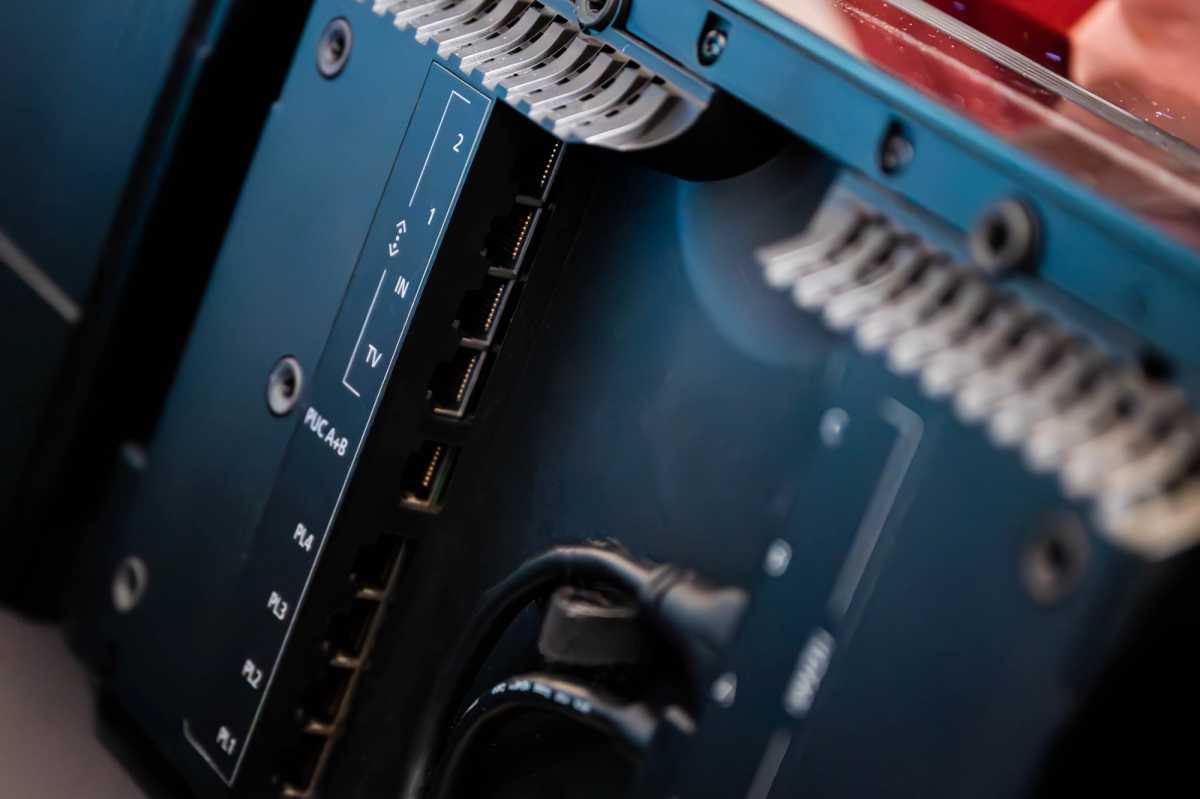
All inputs and connections are located discretely in the rear of the soundbar, including a four-port ethernet switch.
Ephemia Nicolakis/Foundry
Want to go wireless? Dual-band 2.4GHz and 5GHz Wi-Fi 5 is on board, along with AirPlay 2, Chromecast, Spotify Connect, DLNA, and Bluetooth 5.1. For Bluetooth, the AAC and SBC codecs are supported, but no high-resolution codecs such as LDAC or aptX Adaptive.
You also have access to Deezer, QPlay, and your iTunes Library from the Bang and Olufsen app. The Beosound Theatre also works with (but lacks built-in) Google Assistant.
Flexible design and mounting options
The Beosound Theatre’s look and mounting options are all customizable. You can choose an acoustically transparent cloth grille or opt for three responsibly sourced, premium oak covers: light oak, dark oak, or oak. The Theatre’s sound is tuned with the grille on. The oak grille is a pure design element and serves no sonic function.
The Theatre’s aluminum base comes in three finishes: natural silver, gold tone, or black anthracite. It’s stunning.
The aluminum side wings are separate accessories and come in 55-inch, 65-inch, and 77-inch configurations to match corresponding UHD TVs. B&O has a partnership with LG, so if you own an LG Gallery series TV, the aluminum wings will precisely match the width of your LG TV.
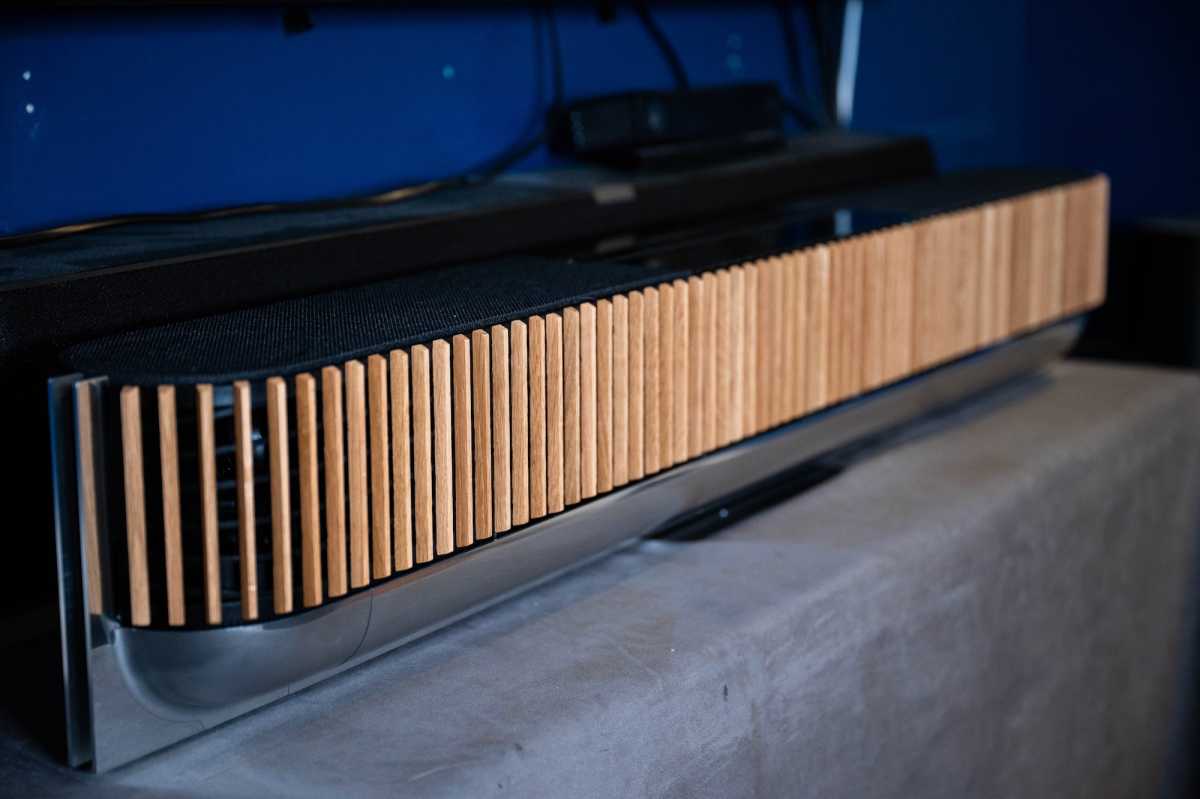
The Beosound Theatre soundbar with a light oak grille and table top stand.
Ephemia Nicolakis/Foundry
You can tabletop-mount, wall-mount, or stand-mount the Beosound Theatre. Of course, each of these options comes with unique B&O functions.
B&O’s motorized, aluminum floor stand matches the Theatre’s finish and comes with a VESA mount that supports the Theatre and virtually any TV up to 77 inches. Functionally, the stand turns 260 degrees to either the left or right.
B&O also offers a motorized, wall mount arm that automatically rotates both the Beosound Theatre and your TV to a pre-defined angle at the press of a button. B&O gave me a live demo of the arm’s functionality and it’s quite impressive.
For tabletop use, B&O sells an optional VESA mount that lets you mount your TV directly on top of the Theatre. Moreover, the VESA mount offers forward and back micro adjustments to align the TV perfectly with the Theatre’s aluminum wings.
My review sample came with the light oak grille, aluminum base, and 55-inch aluminum wings. For my installation, I placed Theatre on a table underneath my wall-mounted TV.
White glove, zero-touch installation and support
How can you be sure you’ll get an optimal setup? While the B&O Beosound Theatre is the most technologically complex and powerful soundbar I’ve ever reviewed, it was also among the easiest to set up, thanks in large part to the step-by-step instructions on the companion iOS or Android mobile app.
Still, a certain segment of B&O’s clientele will surely gravitate to the white-glove installation service option. The installation service is handled by your local Bang & Olufsen dealer and pricing varies by installation type (wall mount, stand mount, and so on).
B&O’s Todd Anderson, the Service and Installation Manager for North America, arrived at my home and walked me step-by-step through a client installation of the Beosound Theatre. With white gloves on, Anderson unboxed, assembled, set up, and configured the Beosound Theatre in our family room.
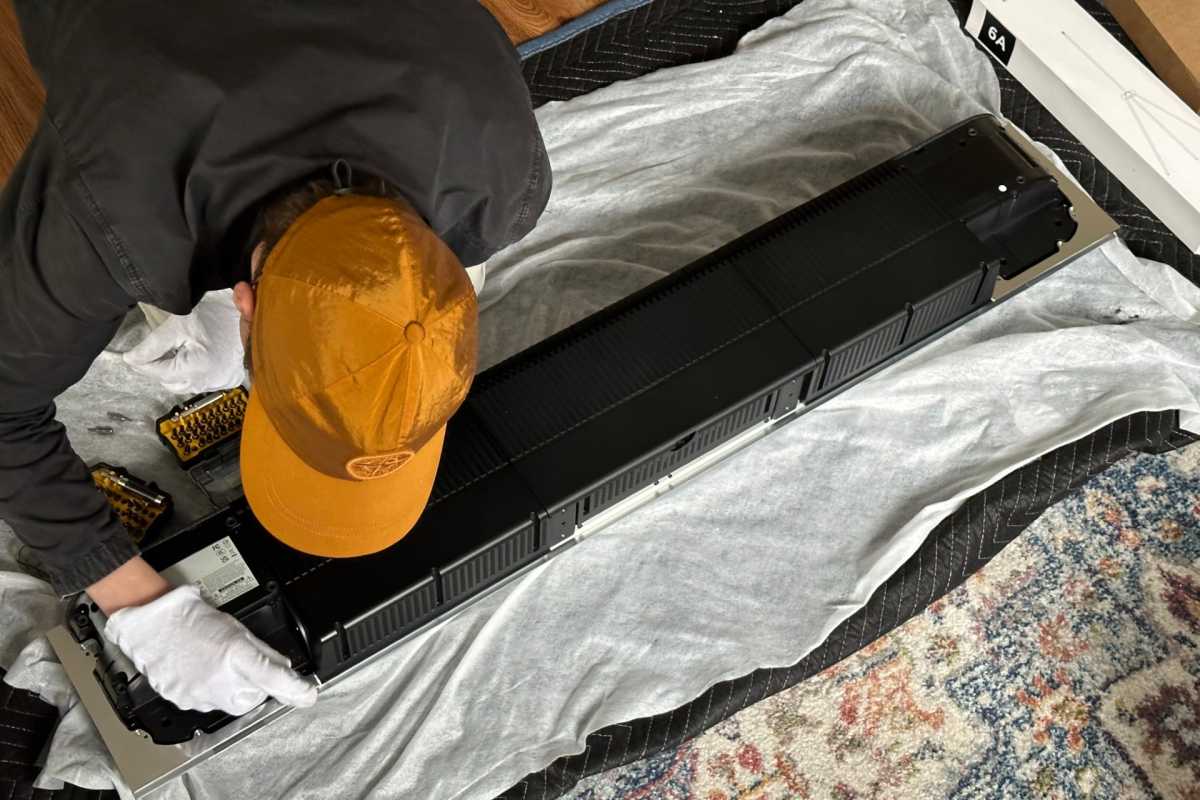
Todd Anderson, B&O’s Service and Installation Manager, performed the white glove installation service for the B&O Theatre review sample.
Ephemia Nicolakis/Foundry
Unlike too many. big-box store installers who read the user manual during installation and know virtually nothing about that product, Anderson had in-depth knowledge of the Theatre and was adept at configuring and optimizing the soundbar for my use cases and home environment. It’s a full-on concierge service.
The Bang & Olufsen app, common to all B&O products, lies at the heart of this premium service experience. Anderson had me go to Support > Access Control and choose the “Give Control” option on the app to generate an access code. He then entered the code into his app.
Anderson never needed access to my phone at any point. Indeed, a B&O installer can perform every aspect of the installation and configuration on your Beosound Theatre without ever touching your personal devices. Anything the installer does—including configurations, preferences, and icon choices—gets copied instantly to your B&O account.
Moreover, if you’ve already configured another B&O device via the app with your Wi-Fi credentials, your Wi-Fi password is copied automatically to the Beosound Theatre and can be shared instantly with any future B&O product.
Busy clients need not be home for the installation either. So long as someone grants physical access, the installer can configure everything on the Beosound Theatre with just the installation code.
The same slick white-glove service continues with support, whether or not you opt for the actual white-glove installation. Should you ever have an issue with the Beosound Theatre, you can contact the 24/7 support and generate another code to grant B&O support temporary remote control of the soundbar to diagnose and resolve any issue remotely.
Premium remote
While you can configure and control all aspects of the Theatre through the mobile app, there’s an optional $375 Beoremote One you can add to the package. The remote connects to the Theatre automatically via Bluetooth, so no line-of-sight is required.
If you have an LG TV, the remote will provide enhanced functionality. And, if you use an Apple TV as I did, the remote will completely replace the need for a separate Siri Remote.
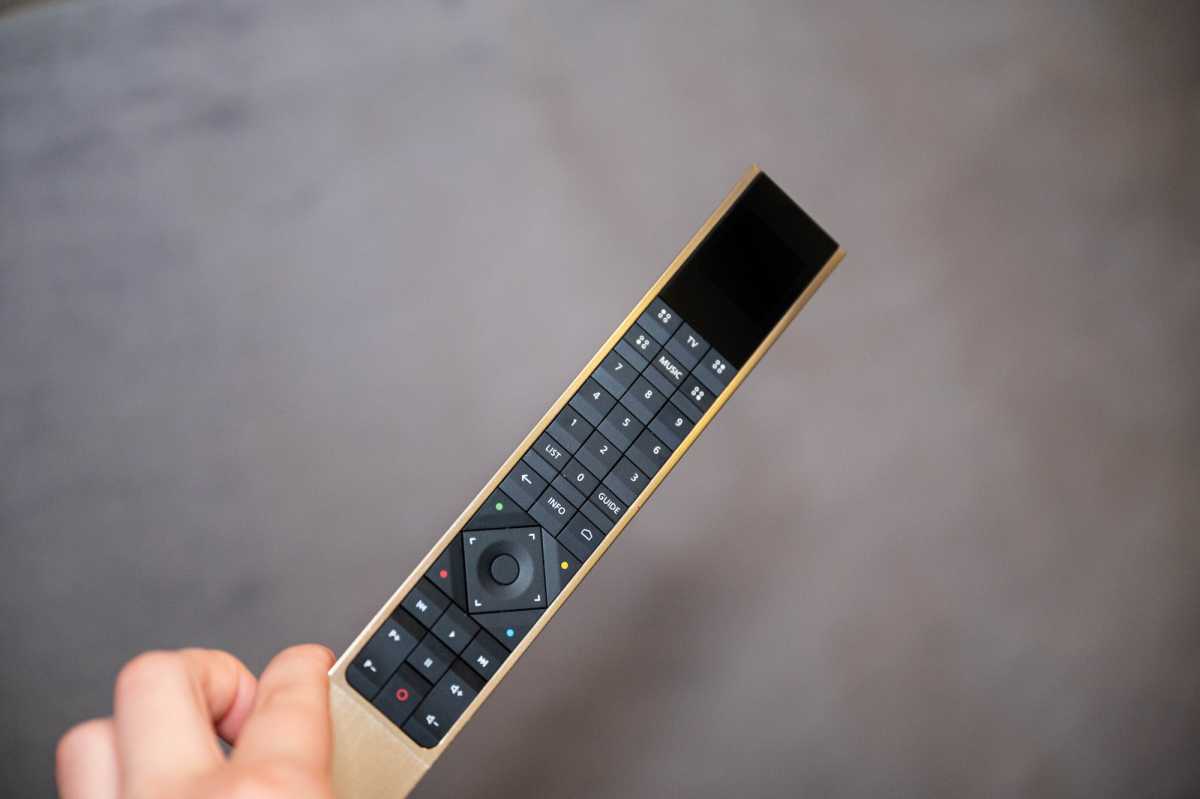
Detail view of the ergonomic B&O remote.
Ephemia Nicolakis/Foundry
RoomSense Room Correction optimizes sound
A room’s size, layout, and furnishings significantly impact a speaker’s in-room performance. Just think about the sonic difference between a gymnasium and your living room. While room correction software is designed to reduce the anomalies created by the room-speaker interaction, that tech is typically reserved for expensive AV receivers and home theater processors.
The Beosound Theater comes with a proprietary room-correction solution called RoomSense. RoomSense uses two built-in microphones in the Beosound Theatre, along with a supplied external microphone that you plug into a port on the front of the Theatre behind the grille. (In typical B&O fashion, even the external microphone is a work of art.)
With a single measurement tone from each channel, RoomSense determines the listening position, assigns the appropriate Speaker Roles, and then optimizes distance and volume levels for each loudspeaker automatically. It takes a mere minute.
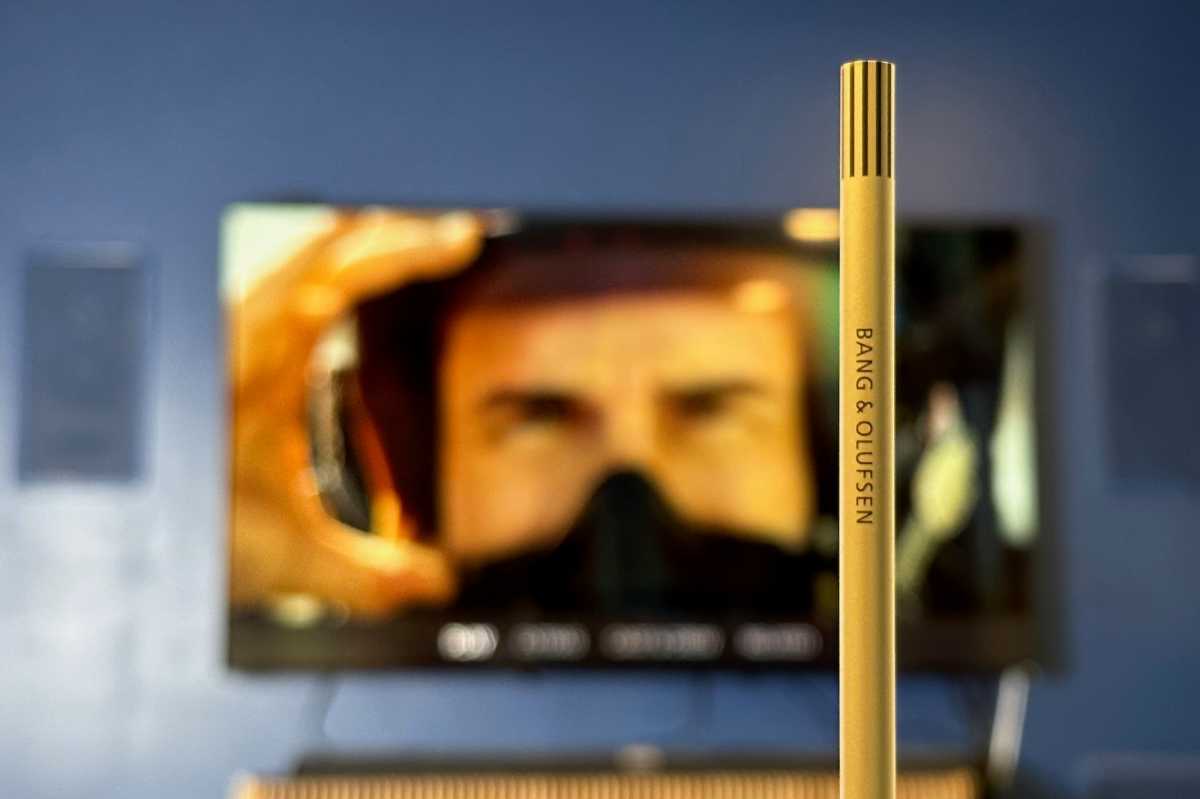
The included calibration microphone helps to optimize the sound of the Beosound Theatre in your room. The microphone itself is a work of art.
Ephemia Nicolakis/Foundry
RoomSense then applies compensation filters accounting for each speaker’s position and room resonances before optimizing the system. It’s sophisticated yet super-simple to use.
A representative from B&O told me that RoomSense on the Theatre works aggressively below 250Hz. This range generally corresponds to what’s known as the Schroeder Frequency for typical rooms, below which the room dominates the sound. Since the Theatre uses only a single microphone measurement, it is less aggressive above 250Hz. RoomSense applies smoothing equalization from 250Hz to 10kHz as opposed to correcting for more narrowband imperfections.
How did RoomSense do? Practically speaking, RoomSense cleaned up a boomy bass response and transformed it into clean, articulate, and authoritative bass lines. I took before and after measurements with REW and found that RoomSense effectively attenuated room modes at around 45Hz and 80Hz by about 7dB. Above 250Hz, RoomSense was indeed less aggressive, simply increasing or decreasing the frequency response at certain points by about 1dB-2dB.
What’s really slick about the Theatre is that you can conduct multiple RoomSense measurements to optimize the sound for different seating areas in your room. You can switch among those profiles on the fly via the Bang & Olufsen app, and you can even configure and activate different speaker groupings connected to the Theatre only for specific seating areas.
Using the Theatre’s 16 speaker expansion ports, you could theoretically have a 7.1.4 setup in one area and then a 2.0 setup in another area and even re-use the same speakers by re-assigning their respective functions; for example, you could make the front-left and side-right speakers work as the front left and front right.
With this functionality, B&O is advancing the concept that sound should move with you around the room and adapt to you, as opposed to you having to adapt to the space. Once again, you generally don’t find this level of flexibility in AV receivers, much less soundbars.
Listening tests
My review setup consisted of the Beosound Theatre and Oak grille ($8,490) and BeoRemote One ($375) for a configured price of $8,865.
I tested the Beosound Theatre in a 26 x 15-foot rectangular room, which opens to a 12 x 12-foot room in the back. The main listening position was about 12 feet from the Theatre, whose tweeter measured about 36 inches from the floor.
I calibrated the Theatre for two additional listening zones: one approximately 45 degrees and 16 feet away and the other further behind the couch in the other room approximately 20 feet from the Theatre.
No matter where I sat, the Beosound Theatre busted out bold, detailed, room-filling sound effortlessly. The Theatre will have no problem in large listening spaces.
By default, the Theatre upmixes all content, including stereo music and TV programming. If this sounds a bit odd in your environment, you can use the mobile app to create a “direct mode” listening preference that will bypass the upmixing feature or optionally attenuate the degree to which this upmixing takes place. The app gives you extensive control to expand the soundstage and immersive impact.
Top Gun: Maverick is an immersive audio demo showcase. At the 1 hour 19 minute mark, Maverick takes out an F-18 for a mock run in the desert. The scene is filled with discrete sonic details and growling bass. The Beosound Theatre delivered the best demo I’ve ever heard on this track from an Atmos-enabled soundbar.
Vocals ranging from Jon Hamm’s lecture to Danny Ramirez’s whisper (“We’ll be sitting ducks for enemy missiles”) were clear and intelligible. Bass lines from the F-18’s engines roared and dug deep with authority, punch, and clarity. The soundstage was tall and wide giving a sense of space, making you feel like you’re there in the cockpit surrounded by a canyon.
Overhead effects, such as those when the F-18 passes overhead on its final ascent to the target, were believable. Likewise, when Maverick successfully blows up the cement bunker, stone fragments and dirt debris spattered overhead and all around.
What’s particularly impressive is that the Beosound Theatre created the slight sensation of virtual left speakers even though my room was open on the left side. A clear shortcoming was enveloping sound effects behind me, which are best served by discrete speakers.
The battle scene above Coruscant at the opening of Star Wars: Revenge of the Sith in Dolby Atmos is another showcase, complete with several discrete and pinpoint side surround, overhead, and enveloping sound effects.
The scene opens with Anakin Skywalker and Obi-Wan Kenobi maneuvering their light interceptors near a Republic attack cruiser. The Beosound Theatre did a remarkable job creating a sense of space, and it shook my room in ways that only discrete subwoofers have accomplished with its reproduction of the Republic attack cruiser’s deep, thunderous engine roar.
That said, my room’s layout detracted from the Beosound’s ability to render discrete sounds in certain locations. For example, sound effects located to the right, such as the missiles chasing Obi-Wan’s light interceptor, were convincing, especially when their sound included height effects. Pans to the left, however, were clearly impacted by the absence of a left wall, thus demonstrating how the Theatre’s performance in your room will vary depending on its physical layout.
Is the Bang & Olufsen Beosound Theatre worth the cash?
The Beosound Theatre may well represent the pinnacle of what a soundbar can be.
In the Theatre, B&O marries aesthetics and high-tech performance into an easy-to-use and want-to-use entertainment package, complete with options to suit just about any aesthetic.
The Beosound Theater’s sound is all B&O. It’s big, bold, clean, and plays far larger than its footprint. You can use the Theatre as a stand-alone soundbar, or you can maximize your immersive experience by adding up to 16 optional speakers. Such expansion options are unprecedented in a soundbar.
Yes, the Beosound Theatre’s breathtaking asking price may put it out of reach for all but the most exclusive clientele. Then again, its flair, flexibility, performance, expandability, ease-of-use, and white-glove setup and support may very well make the Theatre the last soundbar you’ll ever need.

